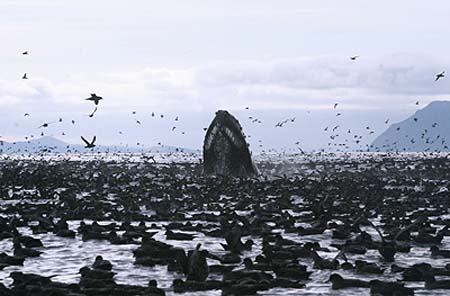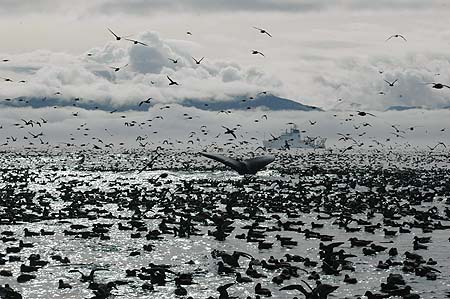Cetacean Assessment and Ecology Program
Assessing Humpback Whale Populations Across the North Pacific: The SPLASH Project
 |
|
A humpback whale surfaces in the midst of a sea of birds. Dozens of humpbacks join hundreds of thousands of
sooty shearwaters to feed on krill off Unalaska Island. Photo by Erin Falcone, Cascadia Research. |
Humpback whales (Megaptera novaeangliae) are distributed throughout the world’s oceans. They are great
wanderers and travel what is probably the longest migration of any mammal, going distances that can exceed 5,000
miles between the cold, productive waters of high latitudes and warm seas in tropical climes. In summer, humpback
whales fatten up on krill and small fish and in late autumn begin their long migration to winter breeding and calving
grounds in low latitudes. During this time, calves are born, males sing complex songs and compete for females, and the
whales fast for weeks or even a few months.
Whaling reduced nearly every humpback whale population to a fraction of its original size, and in some areas (such as
South Georgia in the South Atlantic) stocks were completely destroyed. The North Pacific was once host to many humpbacks;
we don’t have a precise population estimate, but we do know that their population exceeded (perhaps greatly) 10,000 animals.
Humpbacks are found across the entire North Pacific Basin, from California and Central America to Alaska and west to
Hawaii, Russia, Japan, and the Philippines.
In the 1970s, biologists recognized that each humpback whale had a unique pattern of black and white markings on the
underside of its tail, similar to a human fingerprint in that no two patterns are alike. As a result, photographs of
the tail (usually raised in the air when a whale dives) can be used reliably to identify individual whales. This technique
has been widely applied to long-term investigations of living whales in many places in the North Pacific, and some of these
studies have entered their fourth decade; indeed, some whales observed at the beginning of these projects are still being
photographed today. Tracking individuals over time in this way has proved immensely useful. Most knowledge today about the
biology and behavior of humpback whales is a direct result of these long-term studies.
A few years ago, scientists working on humpback whales in the North Pacific joined forces to plan a comprehensive study of
the species across the ocean basin. This large-scale project goes by the acronym SPLASH (Structure of Populations, Levels
of Abundance and Status of Humpback whales) and involves scores of scientists from many countries. The primary objectives
of the SPLASH study are to determine the number of humpback whales in the North Pacific and gather information about
their population structure.
 |
|
A humpback whale dives off Dutch Harbor with the NOAA Ship Oscar Dyson in the background.
Photo by Phil Clapham. |
SPLASH uses a combination of established photo-identification methods (recognizing individual whales from their tail
patterns) and molecular genetics to meet SPLASH objectives. Skin samples are obtained from whales by use of harmless
biopsy darts that extract small plugs of skin and blubber. These samples can be used for hundreds of genetic experiments
as well as sophisticated analyses relating to diet and pollutants.
In collaboraton with scientists from other institutions in California, Washington, Alaska, Canada, and Russia, NMML
researchers conducted work on humpbacks during the summer of 2005, the second feeding season sampled for the SPLASH
project. NMML’s task was to sample whales off Kodiak Island, along the eastern Aleutian Islands, and in the Bering Sea,
from early August to mid-September, aboard the NOAA ship Oscar Dyson.
The cruise was plagued with bad weather and mechanical problems which forced the cancellation of the third leg in late
September; despite this, sampling was remarkably successful. Several large aggregations of humpbacks were encountered,
and the cruise obtained 360 biopsy samples of humpback whales and close to 500 tail photos for individual identification.
Along the way, skin samples were also obtained from killer whales, fin whales, gray whales, and Baird’s beaked whales.
The second leg of the cruise in late August visited the remains of two commercial whaling stations: Port Hobron on Kodiak
Island and Akutan on Akutan Island. These stations operated from 1926 to 1937 and from 1912 to 1939, respectively; they
caught many humpback whales as well as other species, including the now extremely rare right whale. NMML scientists were
pleased to find whale bones still present at Akutan and collected some for DNA analysis.
Skin samples from the summer cruise will go to the Southwest Fisheries Science Center in La Jolla, California, for genetic
analysis which will help to determine population structure as well as sex and genotype of all sampled whales. Photographs
go to the central SPLASH archive at Cascadia Research in Olympia, Washington, where they will be compared to thousands
of other photos taken throughout the North Pacific.
Photographic and genetic matches of the same whale observed in more than one location will provide important insights into
population structure and migratory movements. It will be some time before the results of this huge study are fully analyzed, but
when they are we expect to have a much more thorough picture of the status and biology of humpback whales in the North Pacific.
By Phil Clapham, Paul Wade, and Tony Martinez
>>>continued
 |

|
OND2005 quarterly sidebar
AFSC Quarterly
Research Reports Oct-Dec 2005
Contents
Feature
ABL Reports
FMA Reports
NMML Reports
RACE Reports
REFM Reports
Milestones
Quarterly Index
Quarterly Home
|

